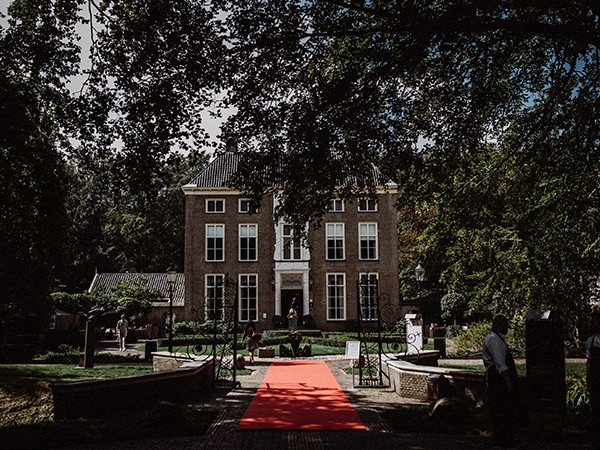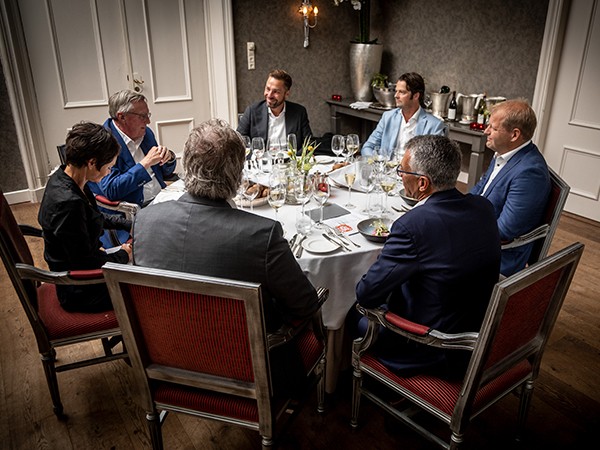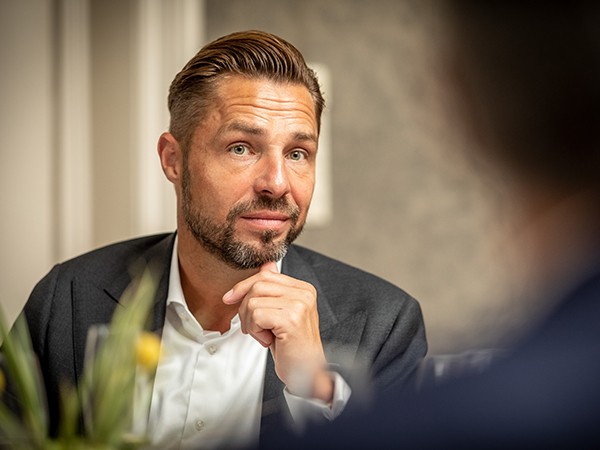
The food industry is facing a number of challenges: reducing CO2 emissions, a shortage of raw materials and resources, rapidly changing consumer trends and a lack of (skilled) personnel, to name a few. What is the role of high-tech, robotics and digitisation in achieving more effective, efficient and sustainable production? We discuss it with four directors from leading companies.
The robot density in agri-food is relatively low, but the industry is catching up. For the time being, the growth is mainly at the beginning and end of the chain. There are drones that inspect crops above fields, robotic machines for targeted crop protection, picking robots in fruit and vegetable cultivation, milking robots in barns and sensors that monitor the welfare, health and production of livestock. At the end of the chain, robots are increasingly taking care of the packaging and labelling of products and the logistics. Albert Heijn is experimenting with dynamic pricing in its stores and is currently testing a fully digital store; a collaboration with the American tech-start up AiFi and ING. The AH-to-go in Zaandam is full of technological innovations. For example, there is no cash register and it is no longer necessary to scan the products yourself. But what about digitisation, automation and robotisation in the food industry? Plenty of reports have been written, with general figures and facts. But what is happening in the field?
While enjoying a nice dinner in Chateauhotel de Havixhorst near Meppel we talk about the role of automation, digitisation and robotisation in the food industry. Ceel Elemans, Sector Banker Food & Agri ING Corporate business, Seine Ligtenberg, ING Director Food & Agri Region North-East Netherlands and trade magazine Food Industry, invited Johan van Marle of Uitgekookt, Peter Lutke Veldhuis of Vleesvee Integratie Twente, Aldo van der Laan of Zwanenberg Food Group and Peter Harmens of the RBK Group, to sit down at the round table. Ceel Elemans introduced the various topics with a stimulating proposition or current question.
Peter Harmens, RBK, kicks off. "We see the food industry becoming increasingly automated and digitised, but robotisation remains a challenge. There are too many variables that you have to respond to. What we have noticed is that the person who selects the machines in the company is often far removed from automation and digitisation. That person looks at 'which machine performs best'. Not so much at 'how can this machine be linked to other machines, how can we collect and exchange data?' As a result, there are often many different machines in a production line that run on different programs. At the same time, the educational requirement for people on the work floor is increasing. Operators need to be almost university-level trained to operate and monitor machines."
Zwanenberg Food Group started automating a long time ago. All kinds of improvements have been made to make the work more pleasant, such as lifting machines and technological clothing especially for working in cold or humid conditions. There are robotic arms that place smoked sausages in the shape of a horseshoe, the sausages are sealed fully automated, and forklift trucks drive without a driver: controlled by radar and wifi. Aldo van der Laan: "The speed of the smoked sausage line could be accelerated by a factor of 2.5 as a result of these investments, the occupancy has been reduced by half. Our people on the production line are now technical operators; that requires more of their abilities. But we also have to deal with seasonal work rush periods, which cannot be compensated for by a robot. We then temporarily hire people. And yes, we know that a quarter of our permanent staff will retire in the coming years. But as long as they're not gone, we can't replace them, can we?"

Clockwise: Aldo van der Laan, Seine Ligtenberg, Johan van Marle, Peter Harmens, Ceel Elemans, Peter Lutke Veldhuis and Judith Witte.
Peter Lutke Veldhuis doesn't think robots will be used in his company in the near future. "Such investments can only be made with larger volumes and sufficient standardisation." He has a relatively large number of Dutch employees, and the staff is loyal. "We have managed to bind them to us, for example by creating a good atmosphere and making the work varied. Everyone can be deployed in several places. The people who work here suit us, and that has grown so much over the years. We cherish the position we are in now. Today's robots are not yet able to cope well with our complex working environment. They are not particularly able to customise with changeable products. When slaughtering pigs, a high degree of automation is possible. This has to do with the mutual proportions in size, shape and weight. This is not possible with cows: the differences here are too great. Finding good professionals is our main concern. But it's not a sexy profession for young people, that's what we're up against."
Aldo van der Laan laughs: "The person who invents the robot for slaughtering cows, will never have to work a day in his life again".
Johan van Marle: "There are probably fewer people working at Zwanenberg than at my company. Our challenge is: how can we grow with as few extra people as possible, while maintaining our goal of producing high quality meals, so that we can distinguish ourselves from other meal providers. ICT is very important to us in this context, and we are really well advanced in this area. Our stock system is based on a sharp and reliable forecast of the purchase. This enables the chef to start the purchasing process on Monday for deliveries during the following week. This gives peace of mind in the workplace, because the chefs know what to expect. In the past, we were always adjusting. We would place orders, which had to be cancelled a day later. The data also saves us money in many areas," says Johan. "And there's probably more to be gained in the area of data analysis."
Harmens: "There is often no time to look at it quietly though."
"That's right", confirms Van Marle.
"But you know exactly what the customers are going to order a week in advance?" asks Peter Lutke Veldhuis in amazement. Van Marle laughs: "Yes! We measure everything... Everything! In the new building, we did not allow ourselves to be tempted by large industrial processes, because we want to deliver the best output, which enables us to distinguish ourselves. Data is essential. Innovation is more about product innovations and tapping into new target groups. In addition to seniors, we are now also going to focus on 'the older single man' and 'the athlete', for example: target groups that continue to order. However, when I think of what Aldo has to say, I think that there is room for more automation for us, while maintaining quality. For example, in dosing techniques."
Aldo van der Laan: "Keep in mind that our target group and goal are not the same in the meals division. The taste and quality of our meals is fine, but of a different level than those of Uitgekookt. The meals are made at Zwanenberg Food UK Ltd. Some 400 people work there, spread over three production locations, producing a wide range of food products under a number of major brands. For the preparation of the meals, a fairly new technique of heating is applied, which makes them preservable for a very long time. We are somewhat limited in the composition of the dishes though; there has to be some liquid like a sauce, and it can only be done with pasta, rice or mashed potatoes. There are also dishes with meatballs, but we have not yet been able to robotise that process; the volumes are still too small for that."
"An additional advantage of digitisation is that we are able to plan stock management and the ordering process more tightly", continues Van Marle. " As we purchase wisely, we throw away far less produce. This is important, for the mentality with regard to waste has clearly changed over the past decade. In the past, too much food was a plus at a catering event. There had to be a lot left over. Which was a positive outcome, because it was a sign that there was more than enough. If there's a lot left over now, you'll be immediately scorned for it."
Peter Lutke Veldhuis is surprised by the image that prevails about waste in the food industry. "Nothing is thrown away, everything has value. Other industries are also doing well in this respect. Vegetable waste, beer brush and beet pulp, for example, are used for animal feed. In my meat farm, everything that comes from the cow is used."

Transparency, and therefore the sharing of information, is essential if we are to achieve better value, but also if we are to guarantee food safety and prevent fraud. Tracking & tracing is impossible without extensive automation and digitisation. "Food quality is now far better than it was 40 years ago, even though this may not seem so, due to the food scandals of recent years," says Peter Lutke Veldhuis. "To guarantee quality, we need to measure and test a lot more than before. Testing more frequently, automatically means discovering more; slaughtering with a zero tolerance is simply impossible. In addition, the legislation surrounding recalls has become stricter. Previously, when something was not quite right during an inspection, you first received a warning. Now everything is stopped immediately, and the sanctions are much harsher. Our solution to keep the risk as low as possible does not lie in robotisation, but in reducing the size of the batches. In that case, the damage is less serious in the event of a recall. For the time being, this mainly results in more manual work."
Peter Harmens: "Automation is possible, but it is expensive because the market for it is small. Nevertheless, we recently developed a new automation system for a veal producer that enables the company to trace more effectively. After a costly recall, the company considered it worthwhile to invest heavily in this system."
Aldo van der Laan: "I think that blockchain can play a major role in this area. The big advantage is that data recorded in a blockchain can no longer be changed. The transparency that it provides, offers possibilities to improve processes. And it guarantees high quality and food safety."
In the food industry, blockchain technology is now being cautiously tested in various chains. In the Frievar pork chain, for example, a pilot with this technology was successfully completed last spring, and now approximately 100,000 Frievar branded pigs are provided with a digital meat passport every year.
And Verstegen Spices & Sauces started a pilot project with Fairfood to use block chain technology to make the nutmeg production chain transparent, which should lead to a stronger entrepreneurial position for the farmer. It is expected that this pilot will be extended to other products in the range of the herbal supplier.
The final stage of the dinner: the desserts. We move to the atmospheric cellar of the restaurant, where we sit down at a long table. There is a nice platter for everyone with various cheeses and matching wines. This is an excellent opportunity to ask the last question: "Food is increasingly referred to as 'experience'," says Ceel Elemans. " Does automation pose a threat? "
Aldo van der Laan responds: "The experience of food is enormously romanticised. In my opinion, there are few people who live up to that food image within their expendable budget. In practice, people eat mainly functionally during the week. The hectic of the day is leading. You come home after work, the children have to go to sports, there has to be something on the table quickly. Convenience, for a small price, is more important than experience. And automation processes in the food industry do play an important role in that area."
Johan van Marle: " For catering and events, that feeling of 'experience' is important. Our chefs are creating a spectacle amidst the guests. The chefs enjoy it a lot. I don't think a robot will ever be able to do it like they can."
The dessert is brought in: colourful plates full of sweet flavours. The conversation moves seamlessly from robotisation and digitisation to subjects that have little to do with the theme. What do we do with the rise of vegetarian food and what does that mean for the butcher's existence in your village?' 'How do you organise the succession of your company?' And now we're ready for a less complex topic: 'How was your holiday?' And: 'Where else in the Netherlands can you eat as well as you do here?' In Brabant, for example, where the next CEO dinner will take place. Then we'll talk about sustainable packaging.
Photos: © Joris Telders
Source: © Vakblad Voedingsindustrie 2019